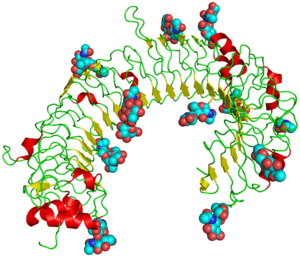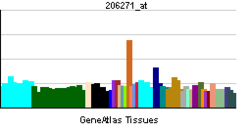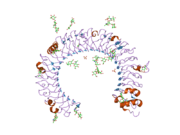TLR3
Toll-like receptor 3 (TLR3) also known as CD283 (cluster of differentiation 283) is a protein that in humans is encoded by the TLR3 gene.[1] TLR3 is a member of the Toll-like receptor family of pattern recognition receptors of the innate immune system.
Function
TLR3 is a member of the Toll-like receptor (TLR) family which plays a fundamental role in pathogen recognition and activation of innate immunity. TLRs are highly conserved from Drosophila to humans and share structural and functional similarities. They recognize pathogen-associated molecular patterns (PAMPs) that are expressed on infectious agents, and mediate the production of cytokines necessary for the development of effective immunity. The various TLRs exhibit different patterns of expression. This receptor is most abundantly expressed in placenta and pancreas, and is restricted to the dendritic subpopulation of the leukocytes. It recognizes dsRNA associated with viral infection, and induces the activation of IRF3, unlike all other Toll-like receptors which activate NF-κB. IRF3 ultimately induces the production of type I interferons. It may thus play a role in host defense against viruses.[2]
TLR3 recognizes double-stranded RNA, a form of genetic information carried by some viruses such as retroviruses. Upon recognition, TLR 3 induces the activation of IRF3 to increase production of type I interferons which signal other cells to increase their antiviral defenses. Double-stranded RNA is also recognised by the cytoplasmic receptors RIG-I and MDA-5.[3]
TLR3 displays a protective role in mouse models of atherosclerosis,[4] and activation of TLR3 signaling is associated with ischemic preconditioning-induced protection against brain ischemia.[5] In addition, TLR3 activators show effects on human vascular cells.[4]
Structure
The structure of TLR3 was reported in June 2005 by researchers at The Scripps Research Institute.[6] TLR3 forms a large horseshoe shape that contacts with a neighboring horseshoe, forming a "dimer" of two horseshoes. Much of the TLR3 protein surface is covered with sugar molecules, making it a glycoprotein, but on one face (including the proposed interface between the two horseshoes), there is a large sugar-free surface. This surface also contains two distinct patches rich in positively charged amino acids, which may be a binding site for negatively charged double-stranded RNA.
Despite being a glycoprotein, TLR3 crystallises readily - a prerequisite for structural analysis by x-ray crystallography.
References
- ↑ Rock FL, Hardiman G, Timans JC, Kastelein RA, Bazan JF (January 1998). "A family of human receptors structurally related to Drosophila Toll". Proc. Natl. Acad. Sci. U.S.A. 95 (2): 588–93. doi:10.1073/pnas.95.2.588. PMC 18464. PMID 9435236.
- ↑ "Entrez Gene: toll-like receptor 3".
- ↑ Alexopoulou L, Holt AC, Medzhitov R, Flavell RA (2001). "Recognition of double-stranded RNA and activation of NF-kappaB by Toll-like receptor 3". Nature 413 (6857): 732–8. doi:10.1038/35099560. PMID 11607032.
- ↑ 4.0 4.1 Cole JE, Navin TJ, Cross AJ, Goddard ME, Alexopoulou L, Mitra AT, Davies AH, Flavell RA, Feldmann M, Monaco C (January 2011). "Unexpected protective role for Toll-like receptor 3 in the arterial wall". Proc Natl Acad Sci U S A 108 (6): 2372–7. doi:10.1073/pnas.1018515108. PMC 3038746. PMID 21220319.
- ↑ Pan LN, Zhu W, Li Y, Xu XL, Guo LJ, Lu Q, Wang J (2014). "Astrocytic Toll-like receptor 3 is associated with ischemic preconditioning-induced protection against brain ischemia in rodents.". PLoS One 9 (6): e99526. doi:10.1371/journal.pone.0099526. PMC 4051824. PMID 24914679.
- ↑ Choe J, Kelker MS, Wilson IA (2005). "Crystal structure of human toll-like receptor 3 (TLR3) ectodomain". Science 309 (5734): 581–5. doi:10.1126/science.1115253. PMID 15961631.
Further reading
- Lien E, Ingalls RR (2002). "Toll-like receptors.". Crit. Care Med. 30 (1 Suppl): S1–11. doi:10.1097/00003246-200201001-00001. PMID 11782555.
This article incorporates text from the United States National Library of Medicine, which is in the public domain.
| |||||||||||
| ||||||||||||||||||||||||||||||
| ||||||||||||||||||||||||||||||||||||||||||||||||



